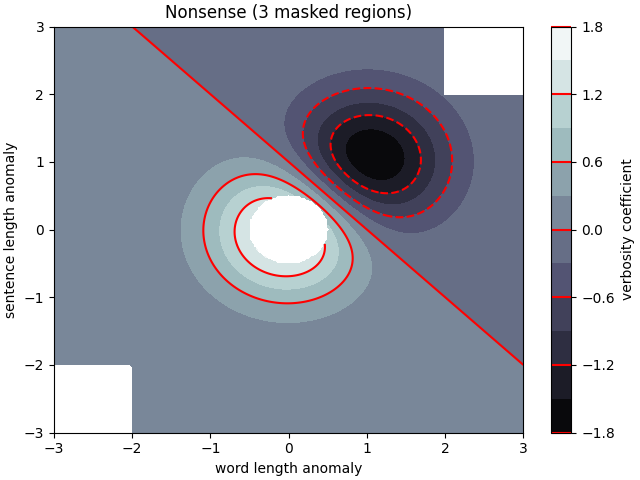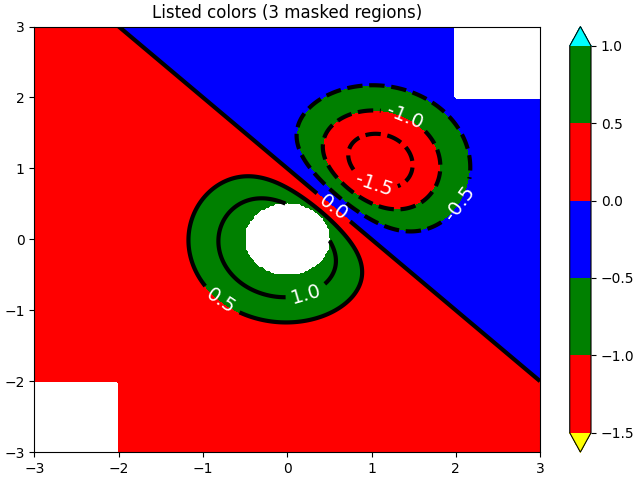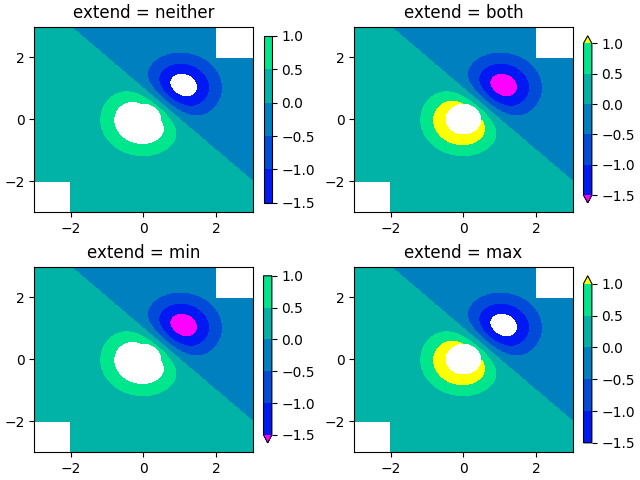Notiz
Klicken Sie hier , um den vollständigen Beispielcode herunterzuladen
Contourf-Demo #
So verwenden Sie die axes.Axes.contourfMethode zum Erstellen von gefüllten Konturdiagrammen.
import numpy as np
import matplotlib.pyplot as plt
origin = 'lower'
delta = 0.025
x = y = np.arange(-3.0, 3.01, delta)
X, Y = np.meshgrid(x, y)
Z1 = np.exp(-X**2 - Y**2)
Z2 = np.exp(-(X - 1)**2 - (Y - 1)**2)
Z = (Z1 - Z2) * 2
nr, nc = Z.shape
# put NaNs in one corner:
Z[-nr // 6:, -nc // 6:] = np.nan
# contourf will convert these to masked
Z = np.ma.array(Z)
# mask another corner:
Z[:nr // 6, :nc // 6] = np.ma.masked
# mask a circle in the middle:
interior = np.sqrt(X**2 + Y**2) < 0.5
Z[interior] = np.ma.masked
Automatische Konturebenen #
Wir verwenden die automatische Auswahl von Konturebenen; das ist normalerweise keine so gute Idee, weil sie nicht an schönen Grenzen vorkommen, aber wir tun es hier zum Zwecke der Veranschaulichung.
fig1, ax2 = plt.subplots(constrained_layout=True)
CS = ax2.contourf(X, Y, Z, 10, cmap=plt.cm.bone, origin=origin)
# Note that in the following, we explicitly pass in a subset of the contour
# levels used for the filled contours. Alternatively, we could pass in
# additional levels to provide extra resolution, or leave out the *levels*
# keyword argument to use all of the original levels.
CS2 = ax2.contour(CS, levels=CS.levels[::2], colors='r', origin=origin)
ax2.set_title('Nonsense (3 masked regions)')
ax2.set_xlabel('word length anomaly')
ax2.set_ylabel('sentence length anomaly')
# Make a colorbar for the ContourSet returned by the contourf call.
cbar = fig1.colorbar(CS)
cbar.ax.set_ylabel('verbosity coefficient')
# Add the contour line levels to the colorbar
cbar.add_lines(CS2)

Explizite Konturebenen #
Erstellen Sie nun ein Konturdiagramm mit den angegebenen Ebenen und mit der automatisch aus einer Liste von Farben generierten Farbkarte.
fig2, ax2 = plt.subplots(constrained_layout=True)
levels = [-1.5, -1, -0.5, 0, 0.5, 1]
CS3 = ax2.contourf(X, Y, Z, levels,
colors=('r', 'g', 'b'),
origin=origin,
extend='both')
# Our data range extends outside the range of levels; make
# data below the lowest contour level yellow, and above the
# highest level cyan:
CS3.cmap.set_under('yellow')
CS3.cmap.set_over('cyan')
CS4 = ax2.contour(X, Y, Z, levels,
colors=('k',),
linewidths=(3,),
origin=origin)
ax2.set_title('Listed colors (3 masked regions)')
ax2.clabel(CS4, fmt='%2.1f', colors='w', fontsize=14)
# Notice that the colorbar gets all the information it
# needs from the ContourSet object, CS3.
fig2.colorbar(CS3)

<matplotlib.colorbar.Colorbar object at 0x7f2d00f39ae0>
Erweiterungseinstellungen #
Veranschaulichen Sie alle 4 möglichen „Erweitern“-Einstellungen:
extends = ["neither", "both", "min", "max"]
cmap = plt.colormaps["winter"].with_extremes(under="magenta", over="yellow")
# Note: contouring simply excludes masked or nan regions, so
# instead of using the "bad" colormap value for them, it draws
# nothing at all in them. Therefore the following would have
# no effect:
# cmap.set_bad("red")
fig, axs = plt.subplots(2, 2, constrained_layout=True)
for ax, extend in zip(axs.flat, extends):
cs = ax.contourf(X, Y, Z, levels, cmap=cmap, extend=extend, origin=origin)
fig.colorbar(cs, ax=ax, shrink=0.9)
ax.set_title("extend = %s" % extend)
ax.locator_params(nbins=4)
plt.show()

Verweise
In diesem Beispiel wird die Verwendung der folgenden Funktionen, Methoden, Klassen und Module gezeigt:
Gesamtlaufzeit des Skripts: (0 Minuten 2,512 Sekunden)